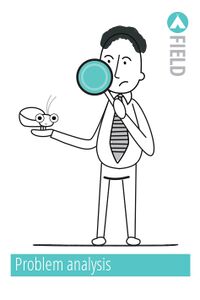Problem Analysis: verschil tussen versies
Naar navigatie springen
Naar zoeken springen
(Nieuwe pagina aangemaakt met '=Why= Put yourself in a position where you are certain that you really understand and can solve the right problem. =How= What is the problem? Why is it a prob...') |
|||
| Regel 1: | Regel 1: | ||
| + | [[Bestand:Field_problem.jpg|200px|thumb|right|]] | ||
=Why= | =Why= | ||
Huidige versie van 16 dec 2019 om 08:33
Inhoud
Why
Put yourself in a position where you are certain that you really understand and can solve the right problem.
How
What is the problem? Why is it a problem? What are possible causes? What are possible solution directions? Break down your 'problem' into the smallest possible parts.
Ingredients
- An inventory of all facets (e.g. sub-systems) having impact.
- Creativity.
- Tangible elements of the possible solution directions.
Practice
Professionals use a problem analysis to get to the objects (process, stakeholder, impact parameter) at the lowest (operational) level, creating a starting point to work on their empirical solution.
